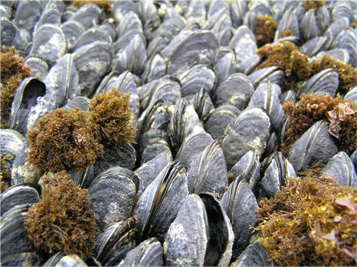Cathy Pfister’s “wow” moment came when she and colleague Tim Wootton were studying the chemistry and sea life of Washington’s Tatoosh Island and found a decrease in pH over an 8-year-period that was an order of magnitude greater than what they expected.
It was a troubling trend—given the problems that sea life can run into as a result of ocean acidification, a change in ocean chemistry accelerated by fossil fuel pollution. As we pump more carbon dioxide into the atmosphere, seawater becomes more acidic and some creatures have trouble building shells and skeletons. In more acidic water, oysters struggle, some forms of plankton dissolve, squid become lethargic, and fish embryos can die. (For more detail on the phenomenon, check out Sightline’s primer on ocean acidification.)
Even on Tatoosh Island, where ecological studies have been underway for five decades, there was little historical pH data to put that alarming drop into context. How unusual was this, wondered Pfister, an associate professor in the Department of Ecology and Evolution at the University of Chicago. That’s how she turned to the historical record hidden inside mussel shells to answer that question. Ultimately, those shells would suggest that some of the changes taking place at Tatoosh Island were unprecedented.
Burning fossil fuels leaves a chemical fingerprint—the carbon it releases has more of the naturally occurring, lighter carbon isotope 12C. Put simply, animals like mussels incorporate carbon into their shells, and scientists can determine how much of the lighter combusted fossil fuel carbon, 12C, is present. And because mussel shells (dating back more than 1000 years) have been collected by the Makah Tribe from archeological sites on Tatoosh Island, they provide a much longer record of these changes.
When the researchers compared modern, decades-old, and archeological shells, they found the carbon composition in the modern shells had rapidly shifted from 13C to the lighter fossil-fuel-sourced 12C over the last decade. There was no precedent for those changes in the historic record, and more puzzling, the shift had happened 2.5 times faster than anyone would have predicted simply from rising amounts of carbon dioxide being put into the atmosphere. As Pfister explains:
It suggests that maybe the nearshore carbon cycle is different than we expected it to be. The nearshore is where we have so many iconic species—the kelp and the big mussel beds and so many of the shelled organisms. You have so many processes going on, loads of animals giving off CO2, loads of algae taking up CO2, rivers bringing in fresh water in this very narrow band along our coastal margins. Yet so much of our ocean research gets done in the offshore…and we’ve been very concerned that people are often using inferences from the middle of the ocean to predict what we should see here.
The researchers tested different theories to try to account for the rapid increase in fossil-fuel-sourced carbon. They thought maybe circulation patterns had brought more upwelled, carbon-rich water to the surface. They theorized that mussels might be concentrating the lighter carbon faster than other animals, or that changes to the food web might be responsible. In the end, none of those theories fully explained the rapid shift to lighter carbon isotopes. It remains, to date, a mystery.
In a companion study, the researchers also found that the thickness of Tatoosh Island mussel shells has declined by 30 percent over the past millenia. Why might that matter? Ocean acidification also robs seawater of available carbonate ions, a key building block for shells and skeletons. Animals have to expend more energy to assemble their shells, and as the oceans become even more acidic, the protective structures can begin to dissolve. The rich mussel beds along Northwest coastlines not only grow mussels, but provide habitat for a wide variety of sea creatures. They’ve been called “apartment complexes” for crabs, snails, worms and seaweeds. If those communities start to deteriorate, it’s hard to predict what kind of other changes might follow.
And for a researcher like Pfister, that’s the more fundamental concern—that we don’t seem to fully understand the possible impacts of the fossil fuel emissions we’re creating today:
The fossil fuels are the link to higher CO2 levels. Do we understand what happens at higher CO2 levels? My concern at this point is, no, we don’t. We’ve got patterns we don’t understand. The question is why, and I don’t have the explanation for you. I do have a deep concern about that.
To learn more about this topic, see Sightline’s blog series: Northwest Ocean Acidification.








